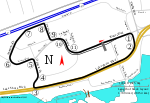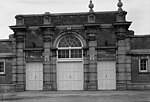2005 Molson Indy Toronto
2005 in Canadian motorsport2005 in Champ Car2005 in TorontoIndy Toronto

The 2005 Molson Indy Toronto was the sixth round of the 2005 Bridgestone Presents the Champ Car World Series Powered by Ford season, held on July 10, 2005 on the streets of Exhibition Place in Toronto, Ontario, Canada. Sébastien Bourdais was the pole sitter and Justin Wilson won the race. It was the first American open wheel victory for the British driver. Sébastien Bourdais took the season points lead by finishing fifth and would end up keeping the points lead for the remainder of the season.
Excerpt from the Wikipedia article 2005 Molson Indy Toronto (License: CC BY-SA 3.0, Authors, Images).2005 Molson Indy Toronto
East Liberty Street, Toronto
Geographical coordinates (GPS) Address Nearby Places Show on map
Geographical coordinates (GPS)
| Latitude | Longitude |
|---|---|
| N 43.637222222222 ° | E -79.415555555556 ° |
Address
East Liberty Street 85
M6K 3P8 Toronto
Ontario, Canada
Open on Google Maps







